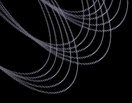
| Home |
| Where to Start |
| News and Updates |
| Tutorials |
| Data Products |
| Data Access |
| Sky Coverage |
| Instruments |
| Data Flow |
| Algorithms |
| Glossary |
| Help and Feedback |
| Search |
 |
The Quality of the SpectrophotometryObtaining accurate spectrophotometry for fiber spectra is a challenging task due to the small size of the fibers relative to the science targets. The SDSS employs some unique techniques which are described on the algorithms page.Below we quantify the spectrophotometric quality of the data by comparing the magnitudes of stars measured in the spectroscopy and the imaging data. We utilize stars for this comparison because the spectrophotometry of galaxies is adversely affected by the smear procedure and quasars are prone to be variable. Synthetic g, r, and i magnitudes are computed from the spectra using the filter curves. We use the fiber magnitudes measured by the photometric pipeline from the imaging data. 
Comparison of g, r, & i magnitudes synthesized from the spectra with fiber magnitudes measured from the imaging data and corrected for galactic foreground reddening. The net offset is in the sense that the spectra are too bright relative to the imaging. This is because the spectra were calibrated to match the r-band fiber magnitudes of standard stars measured with an older version of the photometric pipeline. Older versions of photo (pre v5_3) did not convolve the images to the 2" seeing typical of spectroscopic observations before measuring the fiber magnitudes. A more interesting test is to compare the colors of stars.
A slight offset is evident in the sense that the spectra are too blue by a few percent relative to the imaging. Since the spectrophotometric calibration is computed independently for each half-plate (320 fibers) it is instructive to examine the variation as a function of plate number. 
Comparison of the (g-r) and (r-i) colors of stars in the spectra and imaging as a function of plate number. The small black points are individual stars; the large blue points represent the median. The discreet jump in the colors at plate 432 results from the fact that the standard star target priorities were changed. Note that the spectrophotometry of any individual object is only good to ~10% on average, and may occasionally be discrepant by as much as 50%. To evaluate the spectrophotometry on smaller wavelength scales, we make use of white dwarf spectra. DA white dwarfs have simple hydrogen atmospheres that can be accurately modeled. The strength and shape of the hydrogen absorption features are used to identify DA white dwarfs and to select models of the appropriate effective temperature and surface gravity. The division of the data by the models reveals any spectrophotometric error. 
Comparison of ~200 DA white dwarf spectra to models. The red line represents the median. Clearly there are some ~15% residuals in the spectrophotometry near 4200 Angstroms. These features originate because of a slight mis-match between our template F8 subdwarf and the actual standard stars observed. Future improvements in the spectrophotometric calibration of the SDSS are planned. Last modified: Fri Jun 27 13:21:31 CDT 2003 |
